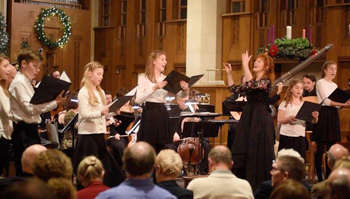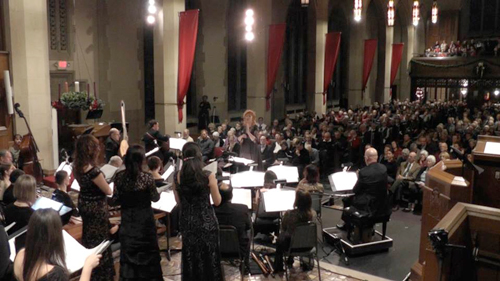by Nicholas Jones

Praetorius shared with other early baroque composers, such as Claudio Monteverdi and Heinrich Schütz, the conviction that music could represent the vast reaches of the Christian universe, pulling humans aloft towards a heavenly life. In this concert, his compositions became an acoustic spectacle that gloriously resonated in the high Gothic nave of First Baptist Church.
Music director and conductor Jeannette Sorrell deftly managed a daunting number of forces, fashioning a remarkably unified effect from a diverse group. Interacting, blending, matching intonation, and working together with obvious pleasure were an octet of superb vocal soloists; the excellent chorus of Apollo’s Singers; a small but highly musical children’s choir; and an unsurpassed orchestra. That orchestra featured the multiple colorations of the early seventeenth century: sackbuts, natural trumpets, and drums for the big, heart-stirring passages; recorders, cornetti, and upper strings for the ornate passage work; and a richly rhythmic continuo of cello and bass, organ, and three — yes, three! — theorbos (those deep-sounding, giraffe-necked Baroque lutes).
Familiar tunes in the program included what must be Praetorius’s best known, the meltingly beautiful carol Lo, How a Rose E’er Blooming, as well as his harmonization of the great Advent hymn, Wachet Auf! (“Sleepers, Wake!”), more often heard in Bach’s cantata. At the end, a spectacular rendition of In Dulci Jubilo was begun by a single treble voice (seventh grader Anna Turner) and grew to a majestic culmination, with the combined forces holding the last chord almost to eternity.
Much of the concert explored lesser-known works of Praetorius, including several extended pieces that should be performed more often. Shaping the first half as a Lutheran Vespers service in Advent (a time of penitence in the church calendar), Sorrell programmed the composer’s hauntingly sorrowful motet Ach, Meine Herre, sung by three wonderful soprano soloists (Nell Snaidas, Molly Quinn, and Amanda Powell), their swirls of anguish accompanied by the dark tones of violas and theorbos.
A more celebratory piece, a German-language Gloria, led us out of the twilight of Advent into the splendor of Christmas. The eight soloists — a well-balanced ensemble of notable talents — moved fluidly around the stage as they combined and recombined in duets, trios, and semi-choruses. Joining the sopranos mentioned above were mezzo-soprano Kristen Dubenion-Smith, tenors Oliver Mercer and Karim Sulayman, and bass Paul Shipper. The orchestra imitated the heavenly hosts with virtuosic scales and roulades, often soaring high above the vocal textures in bursts of instrumental sunshine.
Praetorius’s setting of the Magnificat was the major piece in this part of the program. The constant variety of timbres among the vocal soloists and instrumentalists imbued the performance with the multifaceted wonder that characterizes Mary’s ode to the power of the Lord.
The audience decided not to applaud after the first piece, setting a welcome precedent for a silent appreciation of this reverent music. But it was impossible not to applaud after the strings and recorders performed a medley of secular dances from Terpsichore, with what the Italian Renaissance called sprezzatura — virtuosity without any visible effort.
At the end of each half of the program, enthusiastic ovations left no doubt of the music’s powerful effect. It may be no coincidence that “Praetorius” rhymes with “glorious.”
Photos: Erica Brenner
Published on ClevelandClassical.com December 22, 2015.
Click here for a printable copy of this article




